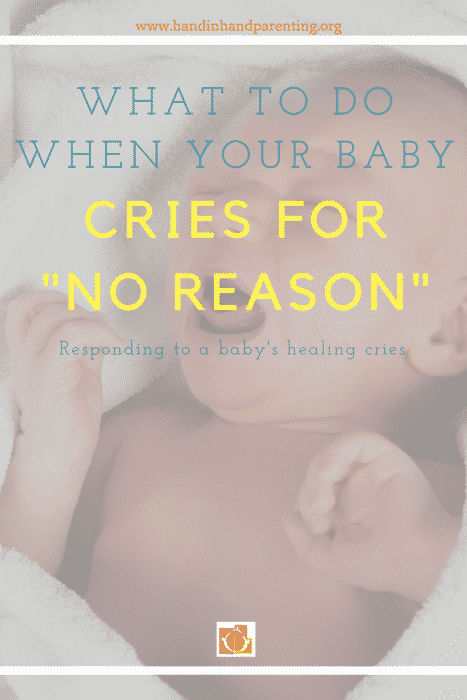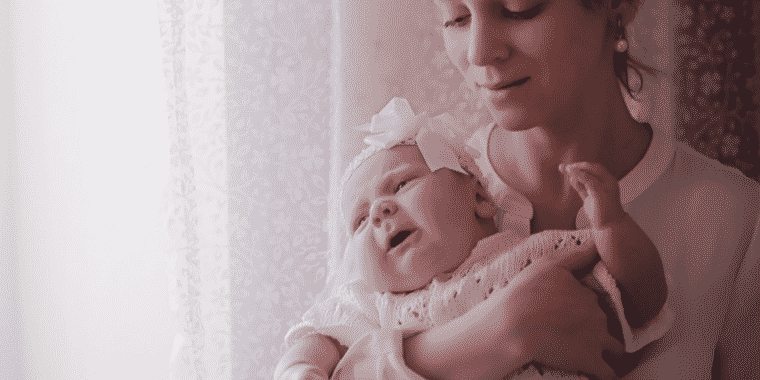![]() A guest post by Grace Fleming and Laura Minnigerode
A guest post by Grace Fleming and Laura Minnigerode
It’s hard to listen when all you want to do is find a way to make your baby stop crying. As a parent you’re hard-wired to care when a baby cries, after all. But sometimes, it feels like babies cry for no reason.
So, how do we listen in a way that’s helpful for a baby in those moments?
What to Do When Your Baby Cries
The steps below are NOT for when your baby is hungry, wet, or hurting. Check if they feeling any kind of hidden discomfort, like a trapped hair around a finger or a scratchy clothing tag. These steps are for those other times. Times when your baby just seems to need to cry. As this article by Aletha Solter explains, these cries are healing cries. Times when a baby has fears and anxiety to process and express. To let go of those feelings a baby needs a supportive, responsive listener… YOU!
In Hand in Hand Parenting, we call this process of active listening Staylistening. If you can’t do it every time, that's ok, it's hard. Please be compassionate to yourself. You’ll have joined a very big club of perfectly imperfect parents!
Respond Calmly When a baby Cries
Step 1: Take a long slow deep breath and relax your whole body. Your baby can tell from your voice, the way you hold your body, how you hold her, if you’re tense. Take a moment to relax. Your baby has real reasons for crying. Maybe she endured a difficult birth. Maybe there has been a time when he had to be removed from you. Maybe she is just making sense of this new world.
In crying this way, your baby is inviting you to listen while he or she lets go of stress.
 Step 2: Make eye contact with your baby. Even if your baby is not returning your eye contact, reach out and connect. Place your hands gently on his body. Stay relaxed and receptive (easier said than done). You listening with warmth will help him let go of his fears and anxiety.
Step 2: Make eye contact with your baby. Even if your baby is not returning your eye contact, reach out and connect. Place your hands gently on his body. Stay relaxed and receptive (easier said than done). You listening with warmth will help him let go of his fears and anxiety.
Step 3: Remind her that you are there, accepting her feelings. You can say calmly and warmly, “I am here,” or “You are safe”. You don’t need to say a lot. You are giving her your calmness and reassurance while he lets go of her upset.
This 3-step process is easier to implement if we ourselves have a calm and warm adult to listen to our upset. Click here for more information about Listening Partnership.
To read more about responding like this to when a baby cries read How Listening to a Micro-Preemie Helped Relieve Her Fear and Some Success Helping my Baby Son Take Naps (with Stay Listening)
You can also get these podcasts for new parents, which explains how Hand in Hand Parenting's gentle approach works with babies.
Facebook Live Series on Babies
Join Laura and Grace for a Facebook Live Series on Babies. Tune in beginning on May 28, 12pm Pacific/ 2pm Central/ 3pm Eastern, when they kick off with “Playful Interaction with Your Baby.” Notice when your baby wants to play, and more!
Meet the Instructors
Grace “Megumi” Fleming, M.S., is a bilingual storyteller, retired psychotherapist, wife, and mom of a grown son in Los Gatos, California. As a Hand in Hand Parenting Certified Instructor, she offers programs in Japanese and English. You can contact Grace through her Facebook Page
Laura Minnigerode is an Ed.M. and certified Hand in Hand Parenting instructor, teacher and educational researcher from Texas. You can contact Laura on Facebook
